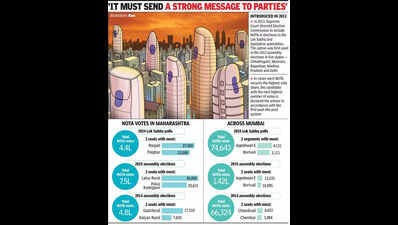Dramatic Rise in NOTA Votes Signals Voter Dissatisfaction in Maharashtra | Mumbai News – Times of India


Almost 7.5 lakh voters in the state chose the NOTA (none of the above) option in the 2019 assembly polls, sending a strong message to political parties. The NOTA turnout, though representing 1.4% of the total votes polled in the election, was an over-55% increase from 2014, expressing dissatisfaction with candidate choices.
The maximum NOTA votes (30,000) in the 2019 polls were cast in Latur Rural, followed by Palus Kadegaon in western Maharashtra (20,631). A political analyst said farmer suicides in the arid Latur region was one of the factors behind voter dissatisfaction, besides issues related to power supply and irrigation. In Raigad, the issues were largely corruption, delays in the completion of the Mumbai-Goa Expressway and a lack of development of tourism and fisheries. Other constituencies with high NOTA votes were Panvel (12,399) and Jogeshwari East (12,031).
Gadchiroli, which in 2014, had the maximum NOTA votes, was an active zone of friction between tribal communities and the administration. Unemployment was a major issue. In Kalyan Rural, there was rapid urbanisation and new housing projects, but related infrastructure projects did not keep pace.
In Mumbai, besides Jogeshwari East, Borivali ranked among the top five assembly constituencies for NOTA votes in the 2019 assembly and the 2024 Lok Sabha polls. Chandivali led in NOTA votes in 2014, followed by Chembur. Jogeshwari East, known for the Save Aarey campaign, has faced environmental challenges. A resident of Bimbisar Nagar, a locality there, said deforestation in Aarey has led to higher temperatures and increased pollution, exacerbated by heavy traffic passing through the Western Express Highway-JVLR junction. “There is round-the-clock traffic chaos and congestion in the area. Locals have raised this issue, to no avail,” said a voter.
Suvarna Joshi from Borivali said, “We have had campaigns against the destruction of mangroves in this constituency. There is discontent among citizens.” Residents of Chembur, which returned a sizeable chunk of NOTA votes in 2014, said they have struggled with air pollution linked to the Deonar dumping ground. In 2008, they organised a hunger strike against frequent fires and smoke. In 2012, local groups filed complaints with BMC regarding smoke affecting asthma patients.
An observer said Chandivali, which recorded Mumbai’s highest NOTA votes in 2014, faced several problems, including poor slum conditions, narrow roads, and delayed rehabilitation projects. Analysts said NOTA should send a strong message to parties fielding candidates. Citizen groups view this trend as a clear indication that voters are increasingly rejecting candidates with questionable backgrounds. Summing up, a member of a Pune-based citizens’ group, said, “The high NOTA numbers show that citizens want clean candidates who can deliver good governance.”















